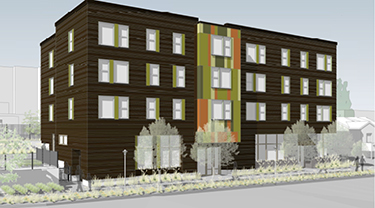|
Subscribe / Renew |
|
|
Contact Us |
|
| ► Subscribe to our Free Weekly Newsletter | |
| home | Welcome, sign in or click here to subscribe. | login |
Construction
| |
 |
July 24, 2014
Behavioral health projects present unique challenges
BNBuilders

Westover
|

Charpentier
|
Behavioral health facility design and construction is an important part of patient care. The external architecture, the interior design, the surrounding environment, as well as the ongoing construction process impact patients and users of these specialized facilities.
New inpatient and outpatient facilities today reflect a modern design approach to healing and recovery, a major departure from clinical hospital environments and culture.
Behavioral health facilities represent unique design features and construction challenges. Project teams must understand the client’s client — the patient — in delivering state-of-the-art facilities with an emphasis on homelike environments.
The vision for hospitals, health providers and design teams is a model of innovative care and a recovery-centered environment, one that is peaceful, serene and free of distraction.
A variety of settings
Behavioral health facilities provide varying services of care, have unique programmatic requirements, and serve different segments of the population. As a result, working with the staff to identify appropriate building components is critical in delivering a facility that meets their specific needs.
In March, BNBuilders completed construction of a two-story, 68-bed addition to Fairfax Hospital in Kirkland using integrated project delivery. BNBuilders, along with the architect Boulder Associates, worked closely with the project team and hospital staff to identify alternate products, such as tamper-proof and anti-ligature systems, that provide a safe environment for both patients and staff, while still providing a setting for recovery.
The resulting facility meets the critical need for expanded behavioral health services for the region, and the addition of this new wing creates the largest private behavioral health hospital in Washington state.
Navos’ Behavioral Healthcare Center of Excellence under construction in Burien is a multi-building campus serving at-risk children, youth, and young adults and their families and caregivers. The expansion includes independent residential quarters for young adults, living cottages and classrooms, a primary care clinic, a multipurpose building, and a full complement of outpatient counseling services.
To achieve Navos’ vision, the project team is creating a safe and secure environment for healing within the natural setting on Lake Burien. The expanded campus and new buildings will give patients the feel of a Pacific Northwest learning community resort.
Spaces were also designed to be flexible so they could be adapted for future needs. The project is scheduled for completion in early 2015.
Treatment centers and clinics are not the only facilities that provide support; a range of supportive housing and residential options provide a safe, healthful and therapeutic environment.
BNBuilders is working with the Community Psychiatric Clinic and SMR Architects to build the 21-unit Valor Apartments, a four-story residential building in Seattle for veterans dealing with behavioral health issues. Community Psychiatric Clinic will be managing the project and providing recovery-focused services to the residents. Valor Apartments will provide a critical link for veterans transitioning from homelessness to independence.
Patient safety
While distinct aesthetic and functional features create warm and welcoming settings for patients, project teams prioritize patient safety during design and in construction. Healing and safety are compatible practices in delivering these facilities.
These safety procedures become especially important when the facility is occupied. At Navos, fencing around the site has additional safeguards with reinforced joints at each panel and privacy screens, to help deter patients from entering the jobsite and getting injured. Additionally, security cameras are posted on the site so that the area is regularly monitored.
Additional safety measures are implemented by owners as well. Navos has classified the construction site as an “imminent danger zone” which allows facility staff to treat their clients with a certain level of care if they do attempt to enter the site.
At Fairfax Hospital, 80 percent of patients are involuntary so facility security is critical, especially with the existing hospital being occupied. Those working on site participated in an orientation where they were made aware of security concerns and the appropriate measure to take if a security breach were to occur. Site access and egress were strictly monitored and many of the same site protection measures as the Navos project were used.
At both facilities, patient privacy, recovery and safety are the top priority, and coordination with hospital staff is paramount in ensuring minimal impacts to those processes.
Embracing AIP
Mental and behavioral health facilities of today require a transformational change in the design and construction process. As the industry continues to evolve, contractors are finding the need to be more integrated and collaborative with the entire project team — architects, owners, subcontractors, users and staff — in order to deliver added value and a facility that meets the needs of the user. Through this approach the project team creates a high-performing environment of teamwork and innovation throughout the duration of the project.
The relationship gap between contractors and designers is narrowing with the onset of new technology, a focus on creating partnerships, and the development of innovative methods for reducing waste. A new design and construction standard, known as advanced integrated practice (AIP), encompasses all of these methods and tools and sets the stage for a superior approach to building.
BNBuilders’ successful delivery of complex projects rests in our culture’s embracing of the philosophical tenets of AIP. Delivery methods such as integrated project delivery, design-build, GC/CM and CM-at-risk are most often associated with AIP and represent a large percentage of BNBuilders’ projects.
Each of these delivery methods require coordination and collaboration that is best approached through a strong partnership in which the general contractor works as a resource for designers and an advocate for the owner. Advanced integrated practices are the blueprint for more innovation and less waste.
The AIP philosophy of early coordination also includes pre-design involvement by the general contractor.
Fairfax Hospital in Kirkland was delivered using integrated project delivery. The BNBuilders team helped Universal Health Services with cost modeling, site selection, completion of the certificate of need application, and revenue evaluations before design began.
This input proved extremely valuable to Universal Health Services and was the beginning of a partnership that has continued on several current projects in Seattle and the Bay Area. For Fairfax Hospital, the result of our partnership is a facility that was built for a significantly lower cost than if a traditional delivery had been used.
Ultimately, the adoption of integrative and collaborative processes, such as AIP, creates value for all involved. Developing partnerships with members of the project team, aligning project goals, utilizing smart technology, reducing waste, and identifying an efficient path to project completion take priority over maximizing profits. Along with partnership and integration, client advocacy makes up the foundation upon which project success is built.
Through recent and current construction of behavioral health facilities in the Puget Sound region, we have recognized that collaborative delivery techniques provide the best value for our clients.
Erik Westover, a project executive at BNBuilders, has spent his career delivering technical health care projects in the Seattle area. Jim Charpentier has over 16 years of experience in the health care industry in Washington.
Other Stories:
- How lean helped hyper-fast project to cross the finish line
- Seattle Children’s psychiatry unit will help kids feel at home
- What’s next for the UW medical center
- Student health centers evolving to provide more holistic care
- How to design and build a plastic surgery center in less than 5 months
- Hospitals have a lot to learn from lean
- You can protect patients with clean construction



